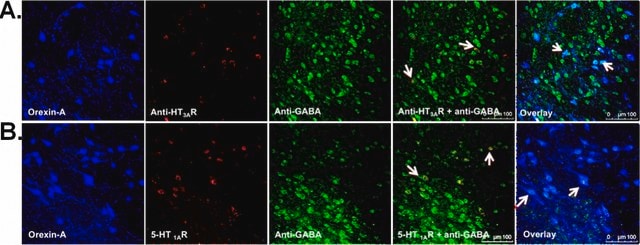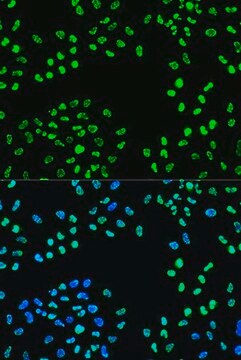AB5020
Anti-Glycine (Low Glutaraldehyde) Antibody
diluted serum, Chemicon®
Sign Into View Organizational & Contract Pricing
All Photos(1)
About This Item
UNSPSC Code:
12352203
eCl@ss:
32160702
NACRES:
NA.41
Recommended Products
biological source
rabbit
Quality Level
antibody form
diluted serum
antibody product type
primary antibodies
clone
polyclonal
species reactivity
rat
manufacturer/tradename
Chemicon®
technique(s)
immunohistochemistry: suitable
shipped in
wet ice
target post-translational modification
unmodified
Specificity
Glycine. The antibody has been calibrated against a spectrum of antigens to assure hapten selectivity and proper affinity. No measurable cross-reactivity (<1:1000) against glycine in peptides or proteins. No measurable glutaraldehyde-fixed tissue cross-reactivity (<1:1000) against L-alanine, gamma-aminobutyrate, 1-amino-4-guanidobutane (AGB), D/L-arganine, D/L-aspartate, L-citrulline, L-cysteine, D/L-glutamate, D/L-glutamine, glutathione, L-lysine, L-ornithine, L-serine, taurine, L-threonine, L-tryptophan, L-tyrosine.
Immunogen
Glycine-glutaraldehyde-BSA
Application
Detect Glycine (Low Glutaraldehyde) using this Anti-Glycine (Low Glutaraldehyde) Antibody validated for use in IH.
Immunohistochemistry using silver-intensified immunogold or fluorescence (see recommended protocol). Samples should be fixed with 0.5% - 2.5% glutaraldehyde for optimum detection.
*This antibody has also been used and found to work with a zero-low glutaraldehyde / high paraformaldehyde fixation (4% paraformaldehyde in 0.1M phosphate buffer / 3% sucrose fixative). The minimum glutaraldehyde concentration for AB5020 is 0.05%. See protocol that follows. Performance is good with frozen sections, Vibratome sections and tissue culture formats, when penetrating reagents such as 0.3% Triton X-100 are used.
Optimal working dilutions must be determined by the end user.
DILUTION: Prepare enough of the AB5020 for your days use by diluting 100X with 1% GSPBT.
*This antibody has also been used and found to work with a zero-low glutaraldehyde / high paraformaldehyde fixation (4% paraformaldehyde in 0.1M phosphate buffer / 3% sucrose fixative). The minimum glutaraldehyde concentration for AB5020 is 0.05%. See protocol that follows. Performance is good with frozen sections, Vibratome sections and tissue culture formats, when penetrating reagents such as 0.3% Triton X-100 are used.
Optimal working dilutions must be determined by the end user.
DILUTION: Prepare enough of the AB5020 for your days use by diluting 100X with 1% GSPBT.
Research Category
Neuroscience
Neuroscience
Research Sub Category
Ion Channels & Transporters
Ion Channels & Transporters
Packaging
2000 assays
Physical form
IgG fraction in sterile 0.1M phosphate buffer. No preservative
Storage and Stability
Maintain stock at 2-8°C in undiluted aliquots for up to 6 months. This stock is extremely stable under normal use and routine storage at 2-8°C. Do not freeze this stock.
Legal Information
CHEMICON is a registered trademark of Merck KGaA, Darmstadt, Germany
Disclaimer
Unless otherwise stated in our catalog or other company documentation accompanying the product(s), our products are intended for research use only and are not to be used for any other purpose, which includes but is not limited to, unauthorized commercial uses, in vitro diagnostic uses, ex vivo or in vivo therapeutic uses or any type of consumption or application to humans or animals.
Not finding the right product?
Try our Product Selector Tool.
Certificates of Analysis (COA)
Search for Certificates of Analysis (COA) by entering the products Lot/Batch Number. Lot and Batch Numbers can be found on a product’s label following the words ‘Lot’ or ‘Batch’.
Already Own This Product?
Find documentation for the products that you have recently purchased in the Document Library.
Franz Weber et al.
Nature, 526(7573), 435-438 (2015-10-08)
Rapid eye movement (REM) sleep is a distinct brain state characterized by activated electroencephalogram and complete skeletal muscle paralysis, and is associated with vivid dreams. Transection studies by Jouvet first demonstrated that the brainstem is both necessary and sufficient for
Optogenetic perturbation of preBotzinger complex inhibitory neurons modulates respiratory pattern.
Sherman, D; Worrell, JW; Cui, Y; Feldman, JL
Nature Neuroscience null
Nadia Parmhans et al.
The Journal of comparative neurology, 526(4), 742-766 (2017-12-09)
We report the retinal expression pattern of Ret, a receptor tyrosine kinase for the glial derived neurotrophic factor (GDNF) family ligands (GFLs), during development and in the adult mouse. Ret is initially expressed in retinal ganglion cells (RGCs), followed by
Lisa Nivison-Smith et al.
The Journal of comparative neurology, 521(11), 2416-2438 (2013-01-26)
Kainate receptors mediate fast, excitatory synaptic transmission for a range of inner neurons in the mammalian retina. However, allocation of functional kainate receptors to known cell types and their sensitivity remains unresolved. Using the cation channel probe 1-amino-4-guanidobutane agmatine (AGB)
Lisa Nivison-Smith et al.
PloS one, 8(3), e58406-e58406 (2013-03-22)
Lampreys are one of the two surviving groups of the agnathan (jawless) stages in vertebrate evolution and are thus ideal candidates for elucidating the evolution of visual systems. This study investigated the retinal amino acid neurochemistry of the southern hemisphere
Our team of scientists has experience in all areas of research including Life Science, Material Science, Chemical Synthesis, Chromatography, Analytical and many others.
Contact Technical Service






